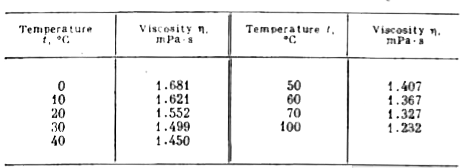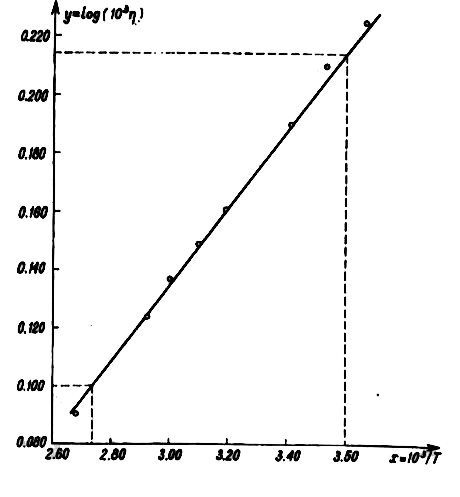The viscosity of mercury decreases with the rise in temperature (Table 21.1a). Check whether relation (34.10) is valid for mercury. Calculate the activation energy.

To check the exponential dependence of viscosity on temperature, find the dependence of the logarithm of viscosity on the reciprocal of the temperature. To do this, compile a new table (Table 21.1b) using the data of Table 21.1a. Using the data of the new table, plot

a graph on millimetre graph paper (Fig. 21.1). Almost all the points are seen to fall on the straight line
y=a+bx,orlog(108η)=a+100+bT=a+BT

Taking antilogarrithms we obtain
103η=A×10B/T
the distinction from formula (34.10) being only in numerical coefficients.
To find the activation energy e, use two points lying on the straight line:
x1=2.75,y1=0.100andx2=3.60,y2=0.213
The temperatures corresponding to these points are T1=103/x1=364KandT2=103/x2=278K and the corresponding visocsities
are η1=10−3×10y1=1.26×10−3 Pa, * s and η2=1.63×10−3Pa⋅s.
The ratio or the viscosities is
η2:η1=eε0/kTe,εε0/hT1=exp{ε0(T1−T2)kT1T2}
Hence we obtain after taking the logarithms
ε0(T1−T2)kT1T2=ln(η2)η1
or ε0=kT1T2ln(η2/η1)T1−T2−2.3kT1T2log(η2/η1)T1−T2
Similar Questions
A glass vessel measures exactly 10cm xx 10 cm xx 10 cm at 0∘C. It is filled completely with mercury at this temperature. When the temperature is raised to 10∘C, 1.6cm3 of mercury overflows. Calculate the coefficient of volume expansion of mercury. coefficient of linear expansion of glass =6.5×10−6C−1.
View SolutionA glass vessel measures exactly 10cm×10cm×10cm at 0∘C. It is filled completely with mercury at this temperature. When the temperature is raised 10 10C,1.6cm3 of mercury overflows. Calculate the coefficient of volume expansion of mercury. Coefficient of linear expansion of glass =6.5×10−6∘C−1.
View Solution
Knowledge Check
Assertion : Viscosity of liquids decreases as the temperature rises.
Reason : At high temperature molecules have high kinetic energy and can overcome the intermolecular forces to flow faster.ABoth assertion and reason are true and reason is the correct explanation of assertionBBoth assertion and reason are true and reason is not the correct explanation of assertionCAssertion is true but reason is falseDBoth assertion and reason are falseAssertion : Viscosity of liquids decreases as the temperature rises .
Reason : At high temperature , molecules have high kinetic energy and can overcome the intermolecular forces to flow faster .AIf both assertion and reason are true and reason is the correct explanation of assertion .BIf both assertion and reason are true but reason is not the correct explanation of assertion .CIf assertion is true but reason is false .DIf both assertion and reason are false .Assertion : Viscosity of liquids decreases as the temperature rises .
Reason : At high temperature , molecules have high kinetic energy and can overcome the intermolecular forces to flow faster .AIf both assertion and reason are true and reason is the correct explanation of assertion .BIf both assertion and reason are true but reason is not the correct explanation of assertion .CIf assertion is true but reason is false .DIf both assertion and reason are false .
A glass flask whose volume is exactly 1000 at 0∘C is completely filled with mercury at this temperature . When the flask and mercury are heated to 100∘C , it is found that 15.4cm3 of mercury overflows. If the coefficient of volume expansion of mercury is 1.8×10−4/K , calculate the coefficient of volume expansion of glass.
View Solution(i) Reactions with low activation energy are fast, while those of high energy of activation are slow.
(ii) The reaction rate almost doubles for each 10∘C rise in temperature although frequency does not change appreciably.
(iii) Calculate the rate constant for the reaction having the activation energy 39.3kcalmol−1
(iv) Calculate the factor by which the rate of reaction is increased for a temperature rise of 10∘C from 25∘C to 35∘C. The energy of activation is 35kcalmol−1.
Given , Ea=35×103calmol−1
R=1.987cal, T2=308K, T1=298K
View SolutionA thermometer is taken from the melting ice into a warm liquid which results in rise in mercury level to 1/5th of the distance between the lower and the upper fixed points. Calculate the temperature of liquid in kelvins.
View SolutionThe volume of a glass vessel is 1000 cc at 20∘C. What volume of mercury should be poured into it at this temperature so that the volume of the remaining space does not change with temperature? Coefficients of cubical expansion of mercury and glass are 1.8×10−4C−1 and 9.0×10−6C−1. respectively.
View SolutionThe volume of a glass vessel is 1000 cc at 20∘C. What volume of mercury could be poured into it at this temperature so that the volume of the remaining space does not change with temperature? Coefficients of cubical expansion of mercury and glass are 1.8×10−4∘C−1 and 9×10−6∘C−1 respectively.
View Solution
